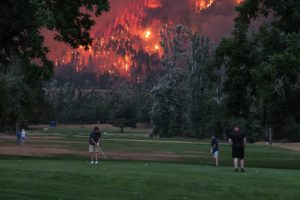Environmental Disasters and the Disadvantaged
 As Hurricane Harvey inundated regions of the southern United States with more than 40cm of rain, Hurricane Irma and Jose trailed behind just weeks later, striking Florida and coastal North Carolina. It has now been reported that Hurricane Maria, a Category 5 Hurricane, is positioned to run through Puerto Rico, Turks and Caicos and the Dominican Republic. On top of this exceedingly strong hurricane season, wildfires in Oregon, earthquakes in Mexico, mudslides in Sierra Lione and Colombia, and flooding across South East Asia, have wreaked destruction on a global level. While natural disasters are difficult to predict, their occurrence remains inevitable, demanding heightened attention for disaster relief.
As Hurricane Harvey inundated regions of the southern United States with more than 40cm of rain, Hurricane Irma and Jose trailed behind just weeks later, striking Florida and coastal North Carolina. It has now been reported that Hurricane Maria, a Category 5 Hurricane, is positioned to run through Puerto Rico, Turks and Caicos and the Dominican Republic. On top of this exceedingly strong hurricane season, wildfires in Oregon, earthquakes in Mexico, mudslides in Sierra Lione and Colombia, and flooding across South East Asia, have wreaked destruction on a global level. While natural disasters are difficult to predict, their occurrence remains inevitable, demanding heightened attention for disaster relief.
While there are many factors that affect the degree of destruction brought by a natural disaster, poverty remains the central determining variable. The Brookings Institute identifies this pattern by first pointing out a 1989 earthquake that struck San Francisco at a level of 7.1 on the Richter scale, causing 21 casualties and leaving 1,200 people homeless. By contrast, the Spitak earthquake that famously ravaged Armenia in 1988 killed some 50,000 people and left over 500,000 homeless, yet the disaster only registered a 6.9 on the Richter scale. It remains clear that the poor and marginalized are at a disproportionately higher risk–– particularly in natural disasters.
Nonetheless, while disaster relief programs aim to aid these very populations, evidence overwhelming demonstrates that natural disasters exacerbate these social inequities. Preferential treatment in times of natural disasters may appear in subtle forms, such as providing greater access to aid in safer communities than in at-risk areas. At the same time, overt discrimination also takes place often during natural disasters. Red Cross notes how Dalits in the Hindu caste system were institutionally forbidden from accessing water after the destruction of a major tsunami and how gender-based violence saw a 536% increase in rape cases after Hurricane Katrina. The issue of social injustice in times of national disaster remains evident, but the role a sustainably-minded individual can play to curb this trend is still a difficult topic to address.
The Importance of Social Participation
One of the most important measures to prevent against discrimination in access to disaster relief aid is to elevate the voices of those disadvantaged. While it might seem like an organizational task to institute overreaching policies for including the opinions of marginalized persons, the individual plays a crucial role in this process as well. Social participation– in the forms of social media involvement and engagement in topical discussions–are two easy ways to help understand complex environmental issues.
Social participation is also crucial for bringing attention to these problems, when those around you may not be aware, and for sharing the opinions of those most deeply affect. In particular, social media is a great tool for discovering how people from various backgrounds are impacted by almost any given issue. Meanwhile, group discussion, whether shared between friends, in a classroom setting, or at the work place, is a necessary action to discover ways you can do to help within your own communities. As natural disasters continue to transpire at alarming rates, it has never been more important for individuals to begin making a commit to center the conversation on helping those most in need. In short, social participation is not just a political point or some humanitarian gesture, but an essential and basic expression of empathy.
-Matt Martin